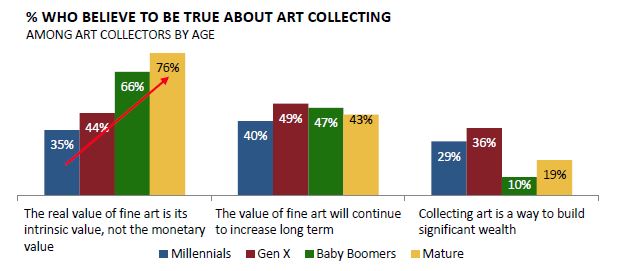US Trust, the private wealth management division of Bank of America released a survey on the difference between young and old art collectors. As collecting and buying habits change, we as appraisers need to be aware of what our clients, and collectors consider when buying fine art. The survey shows there is a difference between how different generation collect and see value in fine art.
According to artnet news, the US Trust surveyed 684 high net worth and ultra high net worth individuals, with assets above $3 million. It seems most millennial's believe in investing in art, and that over time the value will ultimately increase. Millennials, unlike older generations are not buyig for aesthetic value or for cultural/preservation reasons.
artnet news reports
Source: artnet newsA new survey from wealth management firm US Trust points to a deep generational divide between how younger and older art collectors think about their holdings. Among other findings, the "Insights on Wealth and Worth" study suggests that rich millennials might be in for a surprise about the future value of their collections.
US Trust is the private wealth management arm of Bank of America, which sponsors major museum exhibitions, lends money to collectors against their art assets, and handles the finances of various American museums. US Trust has been doing similar studies of very wealthy Americans for several years, but this is the first time they've asked their respondents about art. The report is based on a survey of 684 "high net worth and ultra high net worth adults" nationwide, with assets totaling north of $3 million.
Some of the study's findings might be comforting to those who believe that art's principal worth is aesthetic, intellectual, or cultural. For example, three-quarters of collectors surveyed say their primary reason for collecting is art's aesthetic value.
Other findings may be more alarming, if not entirely surprising. Among millennials, for instance, fully two-thirds believe that the real value of fine art is not its intrinsic value. One in four respondents believe art is an asset "expected to increase in value over time," regardless of age group, and just over sixty percent don't think that investing in art is "risky."
If these younger collectors are buying in expectation of a reliable return on investment, though, they may be in for a surprise, in the bank's view.
Click Chart to Enlarge
"That approach is, in our opinion, not smart," said Evan Beard, art executive at US Trust, in a phone interview with artnet News. Beard joined the company in March after working in art and finance for Deloitte.
"There's a lot of loose language out there on art as an 'asset class,'" he added.
Millennial collectors, Beard pointed out, have had their attitudes formed during a skyrocketing market. They've never seen big downturns in the sector, like their elders.
Related: 10 Exceptional Millennial Artists to Watch
"Younger collectors have grown up in an ecosystem of art as part of the global experience economy, with news-making art fairs and auctions, major economic players associated with art, and big capital inflows," he pointed out.
But Beard points out that those charts that favorably compare performance of artworks at auction against the stock market leave out transaction costs and the price of insurance—never mind the countless artworks that never make it to auction in the first place.
Beard pointed to art history for a lesson in the vagaries of taste and value, referring to the Academic painters who ruled the Paris art scene in the 19th century.
"Meissonier, Gérôme, Cabanel, Bouguereau—they were the big artists of their day," he said. Referring to 1807, Friedland, a large Meissonnier canvas at New York's Metropolitan Museum of Art, he pointed out that in 1876, it went to a department store magnate for a stratospheric $60,000.
"Now," he said, "I imagine some curators would be happy to put it in storage. These days, you often see Meissoniers come up at auction for $10,000."
When it comes to millennial collectors' view of the future value of their holdings, Beard added, dryly, "There may be some rose-colored glasses."
 |


No comments:
Post a Comment